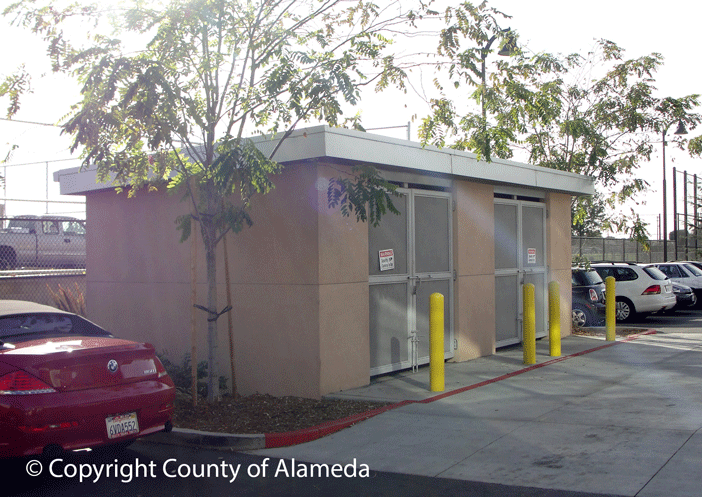You are here: Home » What We Work On » Purchasing » Success Stories in Purchasing » Sustainable Building Design

We ensure new buildings include adequate space to comply with the Alameda County Solid Waste Collection and Organic Waste Reduction Ordinance by providing a design narrative early in the building design process.
Sustainable Building Design
In 2003, Alameda County passed a resolution requiring that all new County construction must achieve a minimum LEED® Silver green building rating. However, our County-specific sustainability priorities go above and beyond what LEED® requires, such as ensuring adequate space and access to meet local recycling and compost mandates and ensuring that dispensers for janitorial supplies meet our green cleaning program specifications. In order to meet these needs, the County developed documents describing the design requirements needed to optimize services like these, as well as performance requirements for products like carpet and paint. These documents are a useful reference tool for County departments working on County-owned building design projects.
- Construction and Demolition Debris Recycling Specification (PDF) *
- Green Cleaning Narrative (PDF) *
- Waste & Recycling Narrative (PDF) *
- Sustainable Building Design Checklist (PDF) *
- Electric Vehicle Readiness Guide (PDF) *
- Low Carbon Concrete Performance Specification (PDF) *
How We Did It:
- We engaged relevant stakeholders, including our construction project managers, our building maintenance department, and vendors like our waste haulers, to ensure all key stakeholder needs were addressed for each sustainability initiative.
- In order to convey our operational needs to our architects and contractors, we developed design narratives describing the design requirements needed to optimize services like electric vehicle charging infrastructure and waste management.
- In order to meet our environmental product performance needs, we leveraged our green purchasing work and developed a checklist of requirements for building materials of interest.
- We continue to revise and iterate each of our documents as we learn through implementing them in County construction projects.
Challenges:
- It can be difficult to strike a balance between the ideal scenarios for our operational needs and the space and cost limitations of construction projects. To accommodate this, our documents reference times in the design process at which to consult with the County's Sustainability Program, to adjust design to meet both environmental performance and the unique requirements of each construction project.
- Our documents need to be flexible regarding how the desired environmental performance is reached, without being so general that environmental performance suffers. To do this, we include both requirements that are necessary to meet minimum environmental performance standards, as well as recommendations for going further based on best practices from previously successful construction projects.
Benefits:
- These efforts ensure County buildings are designed to meet the requirements of local mandates like the Alameda County Solid Waste Collection and Organic Waste Reduction Ordinance and County policies like our Environmentally Preferable Purchasing Policy. (PDF - 110kb) *
- We reduce the environmental impact of County-owned buildings, which constitute about 35% of County's operational greenhouse gas emissions.
- Read more about Alameda County's green building efforts in this award-winning case study published by the Sustainable Purchasing Leadership Council.

